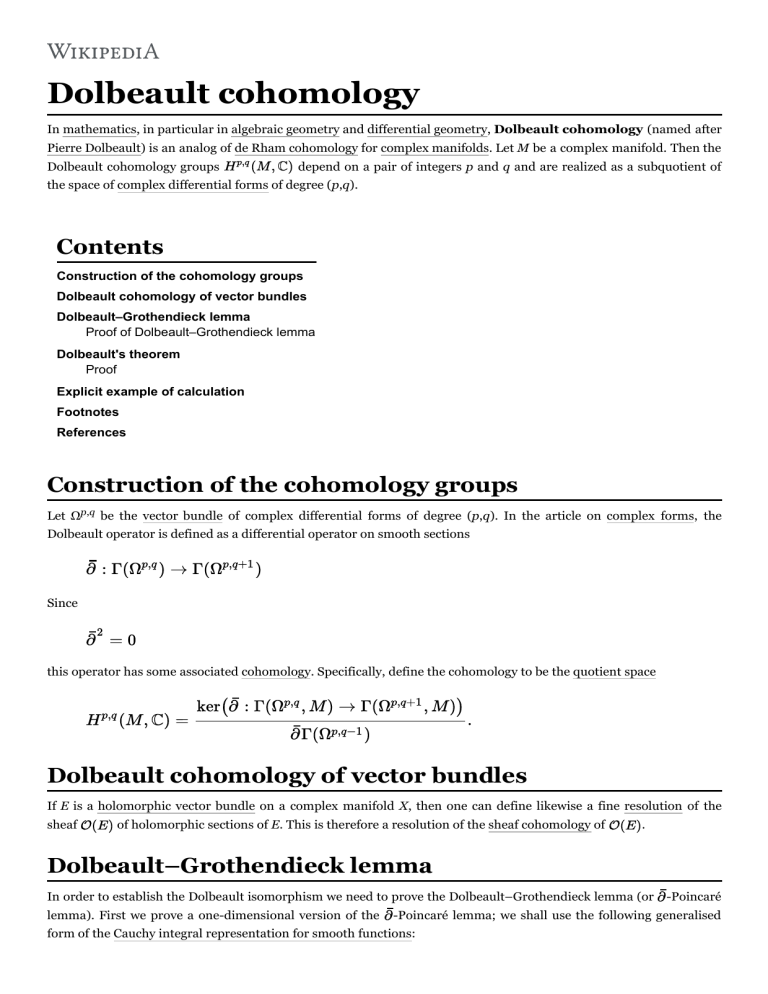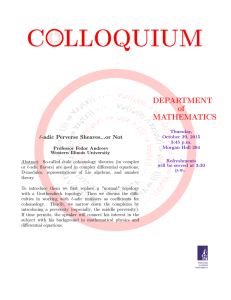Dolbeault Cohomology: Definition, Theorems, and Examples
advertisement

Dolbeault cohomology In mathematics, in particular in algebraic geometry and differential geometry, Dolbeault cohomology (named after Pierre Dolbeault) is an analog of de Rham cohomology for complex manifolds. Let M be a complex manifold. Then the Dolbeault cohomology groups depend on a pair of integers p and q and are realized as a subquotient of the space of complex differential forms of degree (p,q). Contents Construction of the cohomology groups Dolbeault cohomology of vector bundles Dolbeault–Grothendieck lemma Proof of Dolbeault–Grothendieck lemma Dolbeault's theorem Proof Explicit example of calculation Footnotes References Construction of the cohomology groups Let Ωp,q be the vector bundle of complex differential forms of degree (p,q). In the article on complex forms, the Dolbeault operator is defined as a differential operator on smooth sections Since this operator has some associated cohomology. Specifically, define the cohomology to be the quotient space Dolbeault cohomology of vector bundles If E is a holomorphic vector bundle on a complex manifold X, then one can define likewise a fine resolution of the sheaf of holomorphic sections of E. This is therefore a resolution of the sheaf cohomology of . Dolbeault–Grothendieck lemma In order to establish the Dolbeault isomorphism we need to prove the Dolbeault–Grothendieck lemma (or -Poincaré lemma). First we prove a one-dimensional version of the -Poincaré lemma; we shall use the following generalised form of the Cauchy integral representation for smooth functions: Proposition: Let the open ball centered in of radius open and , then Lemma ( -Poincaré lemma on the complex plane): Let satisfies be as before and a smooth form, then on Proof. Our claim is that we choose a point defined above is a well-defined smooth function such that and an open neighbourhood whose support is compact and lies in and is locally -exact. To show this , then we can find a smooth function Then we can write and define Since in then is clearly well-defined and smooth; we note that which is indeed well-defined and smooth, therefore the same is true for . Now we show that since is holomorphic in applying the generalised Cauchy formula to . we find on . since , but then on . QED Proof of Dolbeault–Grothendieck lemma Now are ready to prove the Dolbeault–Grothendieck lemma; the proof presented here is due to Grothendieck[1]. We denote with the open polydisc centered in with radius Lemma (Dolbeault–Grothendieck): Let there exists which satisfies: Before starting the proof we note that any for multi-indices Proof. Let we have then there exists and observe that we can write . Moreover we can apply the . Define -modules, we proceed by ; next we suppose that if are holomorphic in variables satisfy . in the sheaf of . Then suppose on the open ball are also holomorphic in , then -form can be written as since on -closed it follows that on the polydisc then such that on be the smallest index such that such that is open and , therefore we can reduce the proof to the case induction on . For Since where . -Poincaré and smooth in the remaining ones lemma to the smooth functions , hence there exist a family of smooth functions which therefore we can apply the induction hypothesis to it, there exists and such that ends the induction step. QED The previous lemma can be generalised by admitting polydiscs with the components of the polyradius. Lemma (extended Dolbeault-Grothendieck). If is an open polydisc with Proof. We consider two cases: and Case 1. Let and , then . , and we cover Grothendieck lemma we can find forms for some of with polydiscs of bidegree on , then by the Dolbeault– open such that ; we want to show that We proceed by induction on : the case when take and with Then we find a -form an open neighbourhood of lemma to find a and Then holds by the previous lemma. Let the claim be true for defined in an open neighbourhood of then -form on such that . Let be and we can apply again the Dolbeault-Grothendieck such that on . Now, let be an open set with a smooth function such that: is a well-defined smooth form on which satisfies hence the form satisfies Case 2. If instead before, we want to show that we cannot apply the Dolbeault-Grothendieck lemma twice; we take and as Again, we proceed by induction on : for suppose that the claim is true for find a -form the answer is given by the Dolbeault-Grothendieck lemma. Next we . We take such that covers , then we can such that which also satisfies on , i.e. is a holomorphic -form wherever defined, hence by the Stone–Weierstrass theorem we can write it as where are polynomials and but then the form satisfies which completes the induction step; therefore we have built a sequence -form such that which uniformly converges to some . QED Dolbeault's theorem Dolbeault's theorem is a complex analog[2] of de Rham's theorem. It asserts that the Dolbeault cohomology is isomorphic to the sheaf cohomology of the sheaf of holomorphic differential forms. Specifically, where is the sheaf of holomorphic p forms on M. A version for logarithmic forms has also been established.[3] Proof Let be the fine sheaf of forms of type . Then the -Poincaré lemma says that the sequence is exact. Like any long exact sequence, this sequence breaks up into short exact sequences. The long exact sequences of cohomology corresponding to these give the result, once one uses that the higher cohomologies of a fine sheaf vanish. Explicit example of calculation The Dolbeault cohomology of the -dimensional complex projective space is We apply the following well-known fact from Hodge theory: because is a compact Kähler complex manifold. Then Furthermore we know that is Kähler, and the Fubini–Study metric (which is indeed Kähler), therefore and where and is the fundamental form associated to whenever which yields the result. Footnotes 1. Serre, Jean-Pierre (1953–1954), "Faisceaux analytiques sur l'espace projectif" (http://www.numdam.org/item?id= SHC_1953-1954__6__A18_0), Séminaire Henri Cartan, 6 (Talk no. 18): 1–10 2. In contrast to de Rham cohomology, Dolbeault cohomology is no longer a topological invariant because it depends closely on complex structure. 3. Navarro Aznar, Vicente (1987), "Sur la théorie de Hodge–Deligne", Inventiones Mathematicae, 90 (1): 11–76, doi:10.1007/bf01389031 (https://doi.org/10.1007%2Fbf01389031), Section 8 References Dolbeault, Pierre (1953). "Sur la cohomologie des variétés analytiques complexes". Comptes rendus de l'Académie des Sciences. 236: 175–277. Wells, Raymond O. (1980). Differential Analysis on Complex Manifolds. Springer-Verlag. ISBN 978-0-387-904191. Gunning, Robert C. (1990). Introduction to Holomorphic Functions of Several Variables, Volume 1. Chapman and Hall/CRC. p. 198. ISBN 9780534133085. Griffiths, Phillip; Harris, Joseph (2014). Principles of Algebraic Geometry. John Wiley & Sons. p. 832. ISBN 9781118626320. Retrieved from "https://en.wikipedia.org/w/index.php?title=Dolbeault_cohomology&oldid=880436687" This page was last edited on 27 January 2019, at 12:08 (UTC). Text is available under the Creative Commons Attribution-ShareAlike License; additional terms may apply. By using this site, you agree to the Terms of Use and Privacy Policy. Wikipedia® is a registered trademark of the Wikimedia Foundation, Inc., a non-profit organization.




